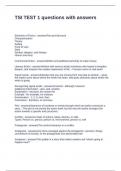TSI TEST 1 questions with answers
Elements of Fiction - answersPlot and Structure
Characterization
Theme
Setting
Point of view
Style
Symbol, allegory, and fantasy
Humor and irony
Commercial fiction - answersWritten and published primarily to make money
Literacy fiction - answersWritten with serious artistic intentions who hopes to broaden,
deepen, and sharpen the readers awareness of life. - Focuses more on real world
Signal words - answersIndicates that you are moving from one idea to another. - gives
the reader clues about where the writer has been, and gives directions about where the
writer is going
Recognizing signal words - answersContrast - although, however
Additional information - also, and, another
Explanation - because, the reason for
Example - for example, for instance
Enumeration - 1, 2, 3, next, then
Conclusion - therefore, in summary
Plot - answersSequence of incidents or events through which an author constructs a
story. - The plot is not merely the action itself, but the way the author arranges the
action towards a specific end (structure)
Conflict - answersA clash of actions, ideas, desires, or wills.
Types: Person vs. person, person vs. environment, person vs. self
Protagonist - answersThe central character in a conflict
Antagonist - answersAny force arranged against the protagonist - persons, things,
conventions of society, or the protagonists own personality trait
Suspense - answersThe quality in a story that makes readers ask "what's going to
happen next?"
, Deus Ex Machina - answersLatin for God from a machine, the saving of the protagonist
from an impossible situation
Symbol - answersSomething that makes more than it suggest on the surface
Style - answersThe manner in which an author uses words, constructs sentences,
incorporates non-literal expressions, and handles rythm, timing, and tone. - When asked
to describe, you are being asked to describe how or explain why the words, sentences,
and imaginative comparisons are effective in the term of what is being created
Characterization - answersAnalyzing characterization is more difficult than describing
plot; human nature is infinitely complex, variable and ambiguous. It is much easier to
describe what a person has done instead of who a person is
Types of characters - answersFlat - usually have one or two predominant traits.
Character can be summed up in a few lines.
Round - complex and many faceted, have the qualities of real people.
Stock - a type of flat character, appears so often the reader recgonizes them right away
Static - remains essentially the same throughout.
Developing - undergoes a significant change during the story
Theme principles - answersIn the form of a statement with a subject and predicate,
stated as a generalization about life, avoid terms like, every, all, and always, the central
and unifying concept of a story, there is no way of stating the theme of a story, avoid
statements that reduces the theme to a familiar saying that we have heard all our lives
Theme - answersExists only when the author has seriously attempted to record life
accurately or to reveal some truth about it, or when the author has deliberately
introduced as a unifying element some concept or theory of life that the story illuminates
Irony - answersA humerous technique with a range of meanings that all involve some
sort of discrepancy of incongruity
Fantasy - answersA nonrealistic story that transcends the bounds of known reality
Allegroy - answersA story that has a second meaning beneath the surface
Verb - answersA word used to describe an action, state, or occurrance, and forming the
main part of the predicate of a sentence, such as hear, become, happen
Reading - answersThe active skill of reading written or printed material silently or aloud
Literacy - answersAbility to read and write




